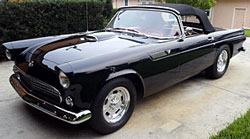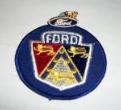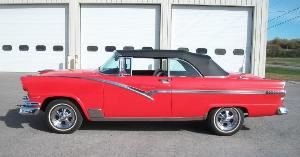|
Group: Forum Members
Last Active: 2 Years Ago
Posts: 476,
Visits: 22.0K
|
|
|
Group: Forum Members
Last Active: 2 Years Ago
Posts: 1.2K,
Visits: 285.6K
|
After working with the repro sender, I have determined it will not work with the gauge I have in my dash. My car was converted to 12 volts before I got it and I have no idea what has been done to it. The right thing to do is to replace both the dash gauge and the sender as a unit. I would advise anyone who is thinking about buying a repro sender to do the same. It looks like Casco has the right parts. For now, I'm keeping my tank full.

|
|
Group: Forum Members
Last Active: 2 Years Ago
Posts: 236,
Visits: 237.6K
|
Yea, it looks like Casco has a new Gauge and Sending Unit designed to work together for the T Bird in fact they warn not to mix original parts with the new as they are not compatible.
Wish they had a solution for my 56 Fairlane that is a 1 year orphan as far as gauges go. I am going to pull the sender and see if it's reparable
|
|
Group: Forum Members
Last Active: 10 Months Ago
Posts: 142,
Visits: 1.5K
|
|
|
Group: Forum Members
Last Active: 2 days ago
Posts: 3.7K,
Visits: 32.6K
|
Brent (1/11/2019)
I tested the sending unit I just purchased from Hill's, a # 9275-B Fuel Sending Unit with Gasket 12V 56. My meter indicates 182-37 Ohms and jumps around through the cycle. I found this sending unit, it gets great reviews at summit. "Tanks Inc 556FS"  It should 73-10 as shown on chart. That is the correct Ohm Rating for a Sending Unit to work with Original Dash Unit. Maybe the One You got is Defective?
 
|
|
Group: Forum Members
Last Active: Yesterday
Posts: 156,
Visits: 11.7K
|
Exactly how do you test the ohm rating of the fuel sender? What do you touch the probes (+ and - ) to on the sender? Thanks for your help and advice.
|
|
Group: Forum Members
Last Active: Last Year
Posts: 257,
Visits: 3.9K
|
The King-Seeley system does not work on "resistance"!!!! The shop manual has a good basic description of its workings.
It works on a system of heating elements and bi-metal-springed points affected either by pressure [in the case of the fuel sender], or heat [in the case of the engine temperature gauge system.
You MAY be able to get a correct range of resistance on an aftermarket sending unit by "fudging" around; however, you can't just measure the sender or gauge resistance and expect to "match" it; it's an entirely different operating principle. To do that, use a variable power resistor of a range from about 20 ohms to about 500 ohms (or some select individual power resistors in that same range), set it at it's maximum resistance range, and insert into circuit IN PLACE OF the sending unit, then carefully and very slowly (over several minutes of time - the gauge is very slow acting) start to reduce the resistance 'till you just notice the gauge coming off of "empty"; then take the resistor out of circuit and measure the resistance: That will be your "high" range end of resistance needed. Re-insert the resistance into the circuit and, again, very slowly start reducing it's resistance until you just "hit" the "full" gauge mark; then re-measure the resistance of the variable resistor: That will be your "low" range end of resistance needed. [You could also try this at "mid" range just to get some idea of your "system's" non-linearity, if you want.] Now you can try to locate an aftermarket "resistance" sender to meet your needs. EDIT: Please note that you need to ind an aftermarket sender that is at it's "high" end of resistance when the float is dropped for empty, and is at it's "low" end of resistance when the float is high for "full"; some senders might be "backwards" from what you need!!!
NEVER apply the full 6 or 12 V to the gauge directly: It will burn out in fairly quick order - this is why you start the resistance check at it's highest resistance!
I've adapted my '55 6V system to a 12 V conversion by using the original sender/gauge SYSTEM, measuring the TOTAL SYSTEM resistance (mine measured about 35 ohms), and adding an equivalent series power resistor in series with the sender/gauge circuit (I "hid" my resistor just under the fuel tank sender access plate in the trunk floor).
In a case like mine [using the original King-Seeley 6V system in a 12 V conversion - NOT the same as the 3rd paragraph above explains in detail for "aftermarket"], the MINIMUM power dissipation rating of the 12-to-6V dropping resistor MUST be figured by calculating the current draw using the circuit voltage-drop (6V -- to drop 12 V to 6 V) divided by the measured resistance (35 ohms in my case) to equal 0.171 Amps [171 mA]; then, taking the voltage drop (6 V) times the calculated current draw (0.171A) which calculates to 1.08 Watts. OR using the voltage drop squared [6*6=36] divided by the circuit resistance [35 ohms] gives essentially the same answer for minimum power dissipation [in watts].
Because of the "intermittent" (continually opening and closing) nature of the sender points in this King-Seeley system, a 1 Watt resistor is probably "adequate", though a two or 5 watt resistor might be more reliable over time for this specific application. You MUST calculate the above for YOUR system; I only used my system for my calculations as an example of how to do it; and, it may NOT fit your system. As usual: It's YOUR responsibility as to whether or not to try and use the above information for YOUR use.
I hope that this information is helpful to others.
Regards, JLB
55 Ford Crown Victoria Steel Top
|
|
Group: Forum Members
Last Active: 10 Months Ago
Posts: 142,
Visits: 1.5K
|
|
|
Group: Forum Members
Last Active: Last Year
Posts: 257,
Visits: 3.9K
|
Yup.
But, when measuring the original King-Seeley sender with a regular portable Digital Multi Meter, the "resistance" will not change with a change in fuel level - it does NOT work that way! See above.
Regards, JLB
55 Ford Crown Victoria Steel Top
|
|
Group: Forum Members
Last Active: 10 Months Ago
Posts: 142,
Visits: 1.5K
|
|